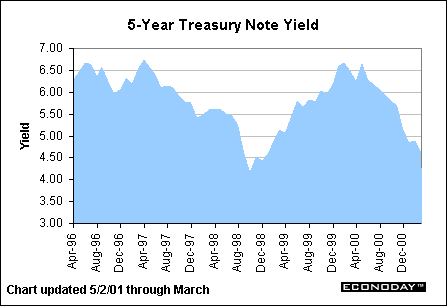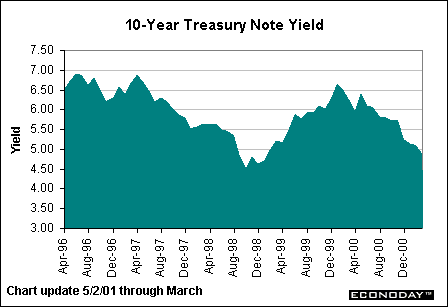The U.S. Treasury released the details of its quarterly refunding announcement today, announcing the auction of $13 billion 5-year notes and $9 billion 10-year notes. This is in comparison with January 31's refunding announcement, which saw the Treasury decide to sell $11 billion each of 5- and 10-year notes and $10 billion worth of 30-year bonds. The Treasury announces the amounts of auctions on the 5- and 10-year notes once every quarter and usually the details on 30-year bonds twice a year (at the February and August refunding announcements).
At the time the U.S. Treasury releases refunding information on its securities, it also releases buyback information for the quarter, any new information, and recommendations from the Bond Market Association. In the last refunding in January, the Treasury announced less buybacks for the first quarter and more cash management bills, while the Bond Market Association recommended that the Treasury consider eliminating the 30-year bond from its auction schedule and totally eliminating the 52-week bill. This month, the Treasury announced that $10 billion of buybacks would occur in the second quarter, with another $10 billion to be bought back in the third quarter, in comparison with the first quarter which saw $8 billion worth of buybacks. The Bond Market Association recommended the elimination of inflation-indexed securities (TIPS) and the weekly issue of 4-week cash-management bills to fund government needs. The Treasury also announced that no decision has been made on the 30-year bond, as it is still reviewing whether or not to eliminate it.
The increase in the amount of 5-year notes from $11 billion to $13 billion, and the decrease in the amount of 10-year notes from $11 billion to $9 billion, reflect supply and demand issues. With the recent surge in agency and corporate supply on the longer end of the yield curve, and with continued strong demand for fixed-income securities, the U.S. Treasury could afford to increase the amount of its shorter-term securities. Demand for shorter-term securities is also strong enough to allow the Treasury to reduce the amount of 10-year notes auctioned this quarter, a move further encouraged by competition from higher yielding, long term non-Treasury securities.
Yields on the 5 and 10-year notes have been rising recently, but are still at low levels compared to a year ago.

Treasury securities have remained fairly even this year, as weak stock prices have raised demand enough to cover fixed-income supply of corporate, agency and Treasury securities. However, the lowering of interest rates has actually hurt the Treasury market as investors have moved money into mortgage-backed agency securities, such as FNMA and FRMC issues, to take advantage of higher yields (relative to the Treasuries) and still relatively low risk.

Damir Fonovich, Market Analyst, Econoday
|